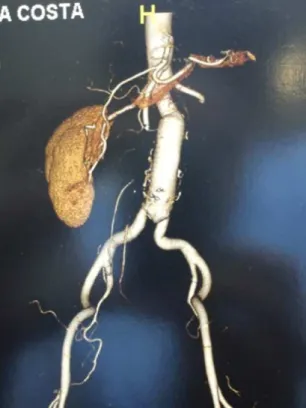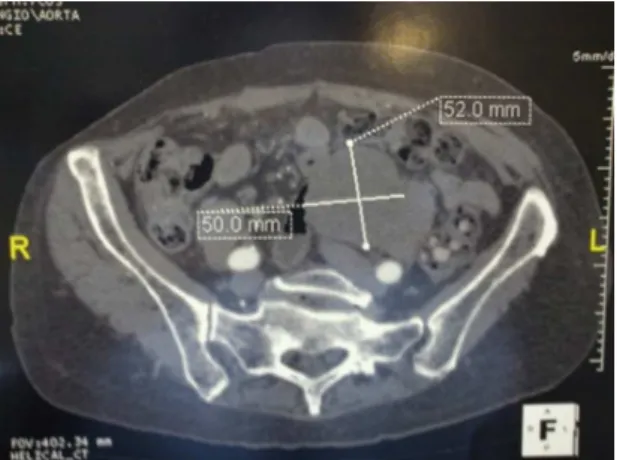180 J Vasc Bras. 2013 Jun; 12(2):180-183
C A S E
R E P O R T
Endovascular repair of abdominal aortic
para-anastomotic pseudoaneurysm
Correção endovascular do pseudoaneurisma para-anastomótico de aorta abdominal
Leonardo Ghizoni Bez1,2, Francesco Evangelista Botelho1, Júlio César Arantes Maciel1, Danilo Martins Cardinelli1
Abstract
Para-anastomotic aneurysms are either true aneurysms or pseudoaneurysms. he latter tend to be asymptomatic until rupture. Para-anastomotic aneurysms should be approached surgically, despite the high morbidity and mortality associated with their treatment. his report describes the case of a 68-year-old woman who presented with a para-anastomotic pseudoaneurysm secondary to infrarenal aortic aneurysmectomy. We chose to use an endovascular approach, and results were good. Endovascular techniques are increasingly becoming the method of choice in the treatment of anastomotic pseudoaneurysms.
Keywords: pseudoaneurysm; aorta; postoperative complications; aortic aneurysm; endovascular procedures.
Resumo
Os aneurismas para-anastomóticos de aorta podem ser verdadeiros ou pseudoaneurismas. Estes últimos tendem a ser assintomáticos até a ruptura. Devem ser tratados cirurgicamente, apesar da alta morbimortalidade em sua abordagem. Este relato descreve o caso de uma paciente do sexo feminino, 68 anos, com quadro de pseudoaneurisma para-anastomótico pós-aneurismectomia de aorta infrarrenal. Optou-se por correção endovascular, com bons resultados. As técnicas endovasculares vêm se estabelecendo como o método de escolha no tratamento dos pseudoaneurismas anastomóticos.
Palavras-chave: pseudoaneurisma; aorta; complicações pós-operatórias; aneurisma aórtico; procedimentos endovasculares.
1 Hospital do Instituto de Previdência dos Servidores do Estado de Minas Gerais – IPSEMG, Belo Horizonte, MG, Brazil. 2 Hospital Felício Rocho, Belo Horizonte, MG, Brazil.
Financial support: None.
Conlicts of interest: No conlicts of interest declared concerning the publication of this article. Submitted: 02.16.13. Accepted: 02.28.13
Leonardo Ghizoni Bez, Francesco Evangelista Botelho et al.
181
J Vasc Bras. 2013 Jun; 12(2):180-183
INTRODUCTION
Para-anastomotic aneurysms may be either true aneurysms or pseudoaneurysms. Its incidence reaches 10% eight to nine years after aneurysmectomy. Pseudoaneurysms tend to be asymptomatic until rupture. They may occur at any time after operation, but its incidence increases with follow-up time. They should be treated surgically even when asymptomatic, because mortality reaches 61% in the case of conservative treatment. However, open
reoperation is technically dificult, and its morbidity
and mortality rates are high.
CASE REPORT
This study describes the case of a 68-year-old woman with hypertension and depression under control, who denied smoking or diabetes. Previous surgeries: appendectomy, perineoplasty, cystopexy, hysterectomy, varicectomy, knee arthroplasty and surgical repair of abdominal aorta aneurysm. Eight years earlier she had undergone infrarenal aortic aneurysmectomy and aortoaortic bypass using a 14-mm Dacron graft. Immediate postoperative recovery was good.
A year and a half after the procedure, a CT angiogram (angio-CT) showed no evidence of abnormalities (Figure 1), and an arterial duplex scan of the lower limbs to investigate popliteal artery aneurysm did not show any changes.
Four years after operation, angio-CT showed Dacron graft dilatation (25 mm diameter), without pseudoaneurysm or leaking. Changes remained stable in the sixth year, and the patient remained asymptomatic.
Eight years after operation she had sporadic abdominal cramps. Ultrasound (US) scanning revealed the presence of biliary sludge, and angio-CT showed a distal thrombosed para-anastomotic pseudoaneurysm measuring 6.0 × 5.0 cm (Figures 2 and 3). An endovascular approach under general anesthesia was selected, and the procedure consisted of dissection of femoral arteries bilaterally, implant of bifurcated steel and Dacron graft (body of graft measuring 26 mm × 82 mm) and extending to the distal third of the common iliac arteries, with a diameter of 12 mm (Figure 4). Postoperative progression was good and she was discharged on the second day after operation. She remains under outpatient follow-up, with no complaints and asymptomatic three years after operation.
DISCUSSION
Of all the complications of aortoiliac bypass grafts, anastomotic pseudoaneurysm is the most common
Figure 1. Angio-CT: Dacron graft and infrarenal aortic bypass anastomosis without pseudoaneurysm; see infrarenal neck.
Endovascular repair of aortic pseudoaneurysm
182 J Vasc Bras. 2013 Jun; 12(2):180-183
late complication. The following complications may be listed: pseudoaneurysm (3%), thrombosis (2%),
enteric erosion/istula (1.6%), graft infection (1.3%),
anastomotic hemorrhage (1.3%), colon ischemia (0.7%) and atheroembolism (0.3%)1. They occur at a
mean 10 to 12 years after operation, affect the distal anastomosis primarily2, and are asymptomatic until
rupture, with a tragic outcome for the patient and the medical team.
The continuous degeneration of the artery wall after graft implantation may weaken the suture between the artery and the prosthesis along the years, which may give origin to the pseudoaneurysm.
Szilagyi reported the occurrence of anastomotic aneurysms in 0.2% of the aortic anastomosis, 1.2% of the iliac anastomosis, and in 3% of the femoral anastomosis three years after operation3. Edwards
reported and incidence of 1% of anastomotic pseudoaneurysm eight years after operation, and 20% 15 years later, with detection at a mean 12 years after operation4.
Imaging follow-up (angio-CT and MRA) for
three to ive years after operation is recommended
to detect new aneurysms or pseudoaneurysms under formation, and therefore avoid rupture5.
Open reoperation is technically dificult because of adhesions and ibrosis, and its mortality rate is 5%
to 17% when elective, and 24% to 88% when there is rupture6. Endovascular repair has a mortality rate
of about 3.8%7.
The endovascular approach has gained importance, with successful results in several case series6-10.
It reduces morbidity and mortality, particularly in high-risk surgical patients. Its initial technical success is about 98% at the time of implantation, and it reduces perioperative mortality to about 3.8%7,9. Despite the complications associated with
endoprostheses, such as endoleaks (type II are the most common), thrombosis, migration, rupture, structural failures and infections, short- and long-term follow-up shows lower complication rates than open surgery. This suggests that the endovascular approach
may deinitely become the method of choice for the
treatment of anastomotic pseudoaneurysms6-9.
In the case reported here, the patient underwent follow-up using imaging tests every two years, and a pseudoaneurysm of the distal aortic anastomosis was detected eight years later. The patient had discrete abdominal pain that radiated to the dorsal region. Abdominal ultrasound detected gallstone, and the hypothesis of pain of biliary origin was raised.
Radiological follow-up showed an increase in the diameter of the pseudoaneurysm, and the endovascular repair was chosen. Abdominal pain resolved completely and the abdominal mass regressed. After three years of follow-up, the patient remains asymptomatic and imaging control has not detected any changes to this moment.
CONCLUSION
The chance of developing a para-anastomotic aneurysm or pseudoaneurysm increases and may reach 20% 15 years after operation, which increases
the chances of rupture signiicantly. Most cases have
an asymptomatic progression until rupture, and the outcome is tragic.
Figure 3. Angio-CT: axial view shows 52-mm pseudoaneu-rysm in distal anastomosis.
Leonardo Ghizoni Bez, Francesco Evangelista Botelho et al.
183
J Vasc Bras. 2013 Jun; 12(2):180-183
7. Sachdev U, Baril DT, Morrissey NJ, et al. Endovascular repair of para-anastomotic aortic aneurysms. J Vasc Surg. 2007;46(4):636-41. PMid:17764881. http://dx.doi.org/10.1016/j.jvs.2007.05.032
8. Mitchell JH, Dougherty KG, Strickman NE, Mortazavi A, Krajcer Z. Endovascular repair of paraanastomotic aneurysms after aortic reconstruction. Tex Heart Inst J. 2007;34(2):148-53. PMid:17622359 PMCid:1894696.
9. Ten Bosch JA, Waasdorp EJ, De Vries JP, Moll FL, Teijink JA, Van Herwaarden JA. he durability of endovascular repair of para-anastomotic aneurysms after previous open aortic reconstruction. J Vasc Surg. 2011;54(6):1571-8. Epub 2011 Sep 23. PMid:21944919. http://dx.doi.org/10.1016/j.jvs.2011.04.072
10. Pifaretti G, Tozzi M, Lomazzi C, Rivolta N, Caronno R, Castelli P. Endovascular treatment for para-anastomotic abdominal aortic and iliac aneurysms following aortic surgery. J Cardiovasc Surg. 2007 Dec;48(6):711-7.
Correspondence
Leonardo Ghizoni Bez Rua dos Otoni, 909 – sala 2002 – Santa Eigênia CEP 30150-270 – Belo Horizonte – MG – Brazil Email: lgbez@terra.com.br
Author information
LGB is a vascular surgeon at Hospital Felício Rocho and head of the Vascular Surgery Service at Hospital do Instituto de Previdência dos Servidores do Estado de Minas Gerais (IPSEMG). Member, SBACV. FEB is head of the Vascular Surgery Residency Program at Hospital do Instituto de Previdência dos Servidores do Estado de Minas Gerais (IPSEMG). JCAM and DMC are resident physicians in Vascular Surgery at Hospital do Instituto de Previdência dos Servidores do Estado de Minas Gerais (IPSEMG).
Author’s contributions
Conception and design: LGB Analysis and interpretation: LGB Data collection: LGB, JCAM, DMC Writing the article: JCAM, DMC Critical revision of the article: LGB, FEB Final approval of the article*: LGB, FEB Statistical analysis: N/A Overall responsibility: LGB
* All authors should have read and approved of the inal version of the article submitted to J Vasc Bras.
Para-anastomotic aneurysms are the most common late complication of the conventional repair of abdominal aorta aneurysm. Adhesions and
inlammation caused by the aneurysm and by the
previous surgery may complicate surgical access for the correction of this complication, and morbidity and mortality rates are high.
An interesting option, which has shown good short- and middle-term results, as long as the patient’s anatomy is favorable, is the endovascular approach, which reduces morbidity and mortality when reoperating this type of late complication of aortic repair.
REFERENCES
1. Hallett JW Jr, Marshall DM, Petterson TM, et al. Graft-related complications after abdominal aortic aneurysm repair: reassurance from a 36-year population-based experience. J Vasc Surg. 1997;25:277-284. http://dx.doi.org/10.1016/ S0741-5214(97)70349-5
2. Biancari F, Ylýnen K, Anttila V, et al. Durability of open repair of infrarenal abdominal aortic aneurysm: a 15-year follow-up study. J Vasc Surg. 2002;35:87-93. PMid:11802137.
3. Szilagyi DE, Hageman JH, Smith RF, Elliott JP. Spinal cord damage in surgery of the abdominal aorta. Surgery. 1978;83:38-56. PMid:619471.
4. E d w a r d s J M , Te e f e y S A , Z i e r l e r R E , K o h l e r T R . Intraabdominalparaanastomotic aneurysms after aortic bypass grafting. J Vasc Surg. 1992;15:344-350. http://dx.doi. org/10.1016/0741-5214(92)90256-8
5. Hertzer NR, Mascha EJ, Karafa MT, et al. Open infrarenal abdominal aortic aneurysm repair: the Cleveland Clinic experience from 1989 to 1998. J Vasc Surg. 2002;35:1145-1154. PMid:12042724. http://dx.doi.org/10.1067/mva.2002.123686

